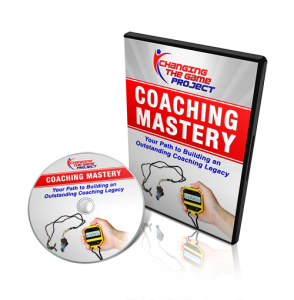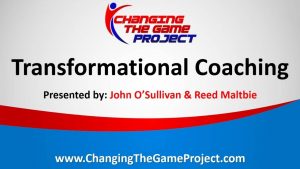This post was provided by Change the Game Project
By John O’Sullivan
Imagine youth sports was a room. On one end of the room, there is a door where everyone enters. At the other end, there is another door where everyone leaves.”
So began a long conversation I had with Peter Hugg, the Head of Football (soccer) for Football New South Wales in Australia, on my recent trip to Sydney. Peter has a long history in the sport, having been involved in three World Cups, three Olympic games, as well as head of Football for Western Australia and high-performance manager for Soccer Australia.
“We spend a lot of time finding ways to get kids to come through the entry door, but we don’t pay nearly enough attention to the burn rate when they get into the room. So many kids just pass right through, out the back door and onto the next thing. We have to put our focus on the kids in the room!”
I couldn’t agree more. And I believe nearly every sport governing body in every sport feels the same way. All but two sports in the US are losing more players each year than they are adding (hockey and lacrosse are the exceptions). It’s not just about getting kids in the game; it’s about keeping them.
How can we keep them? Sports across the United States are currently releasing their version of Long Term Athlete Development (LTAD) plans, called the Athlete Development Model in the US. These mimic plans in countries such as Canada and Australia, and they provide an important framework for providing athletes with the right type of experience at various ages and stages of their development.
My worry is that the message of LONG Term Athletic Development gets emphasized and marketed, often at the expense of the one thing that actually keeps kids in sports for the long term: S.T.A.E.
Short
Term
Athlete
Engagement.
“If sport was only about skill development…and was not practiced by people who have emotion, and care and are human beings, if they were robots, then you would say yes, just do skill, just do deliberate practice…but the problem is that sport is not only about skill development…and sport specific skill. Sport is about motivation, interest, drive, grit, persistence, and resilience, and those types of subjective skills are very important aspects of elite athletes and long-term sport participation and that is the problem… these thing are harder to measure… so we default to skill, and practicing repetition of backhands…But people are not robots, we have to teach the other qualities that combine motivation and interest. That is what play and diversity of sport will do.”
In other words, before we pour in the long-term deliberate practice aspects of sport, focused on what today’s training will provide to an athlete five years from now, we must simultaneously engage our athletes in the short term.
There is no long-term development without short-term engagement! The two go hand in hand.
I do believe that our sport governing bodies see the importance of this, and the ADM done right, as USA Hockey has done, has led to more athlete engagement, and increased retention rates (they have increased their retention of 9-14-year-olds to 91%!). They are keeping the kids in the room!
So how do we do this? How do we keep our athletes engaged in the short term and developing over the long term? Here are some critical qualities that every experience, on a weekly basis, should have:
Enjoyment: we have said over and over, this is the cornerstone of any long-term participation. Kids, especially young ones, will not voluntarily continue to pursue something they do not enjoy. Telling a 7-year-old “This will matter when you are 18” means nothing. It may be true, but it does not make it relevant to him or her. But working on those aspects of development in an enjoyable manner will keep them engaged. The best way to do this is playing lots of games, and ditching the lines and overreliance on unopposed activities. Let them play, add constraints and conditions, manipulate numbers and space, but let them play!
Developing Competence: Kids need to see and feel themselves improving. We cannot default to “fun games and fooling around” at the expense of teaching. Getting better is one of the primary ways children describe “fun” in sports. A quality, engaging sports experience has to teach technical and tactical aspects of the sport, and help children on the path to improvement and mastery. We can teach through games, add defenders and decisions, and kids will develop competence quicker than blocked, repetitive training of a single skill in isolation. Competence and engagement go hand and hand when done correctly.
Nurturing Confidence: This is one of the byproducts of competence. A child who works hard and sees himself improving gains confidence. That confidence is enhanced, or shattered, by the coaches, parents, and team dynamics (more about this later). Our job as coaches and parents is to ensure our athletes are growing in confidence, not by shouting false platitudes at them, but by helping them have a growth mindset, teaching them to embrace the process of improvement, and never letting our words and actions in emotional situations – such as the ride home – sap their self-esteem and belief. We can teach, correct errors, and still help athletes believe in themselves.
Building Connection: Positive team dynamics are a top “Fun factor” for kids in sport. This means coaches must intentionally and continuously build positive, highly-engaging team dynamics, even in individual sports (see the PGA Junior League in Golf for an example). Great teams drive engagement, and engagement keeps kids in the game. By the same account, lousy team dynamics, infighting, lack of trust, bullying, and the like will never promote long-term athlete development nor will they help engagement.
Giving Kids Autonomy: If you want engagement, kids need to own the experience. We can introduce them to sports, but eventually, the experience must become theirs, and not ours. It must be their dreams, their goals, and their intrinsic motivation to play, not those of the adults. Be aware of your kids’ goals for playing, be in tune with when they might need a break or some time away, and pay close attention that sport is something they do, not who they are.
Providing Time Off: Even professional athletes get time away from a sport to recharge their batteries, heal up physically, and refocus. Time off allows athletes to work on movement, strength, flexibility, and injury prevention. It also allows them to pursue other interests, hobbies, and passions. If a child loves to play a sport, a few weeks or even months of downtime from organized practice and competition will not reduce their love of the game. It will make them really excited and hungry to play again. They might even play some pickup. That is engagement.
Intentional Character Development: It is our job to intentionally teach character through sport, not only because we want kids to have the character to sustain their talent, but because developing character also creates engagement. Sports help develop grit, resilience, integrity, empathy, respect, and other traits that help them find success. When they work through the process and embrace the struggle to overcome an obstacle or learn a new skill, that feeling of accomplishment and confidence is intoxicating. Athletes want more of that. They say “what’s next?” That is engagement.
The introduction of Long Term Athlete Development Models in sports are an important step in integrating the technical and tactical development of young athletes with their psycho-social needs, emotional capabilities, and ages and stages of development. If we want to keep kids in a sport for the long term, it is critical to have a roadmap based on something more than a hunch.
But we must always remember the words of Dr. Jean Cote. These kids are not robots, who simply need programming and technical practice. They are human beings. They are individuals who do not so easily conform to a one size fits all roadmap. They do not develop in a linear fashion. They need interest, motivation, persistence, and enjoyment. We can never, ever forget that within each stage of LTAD, we must focus every day on STAE
Short.
Term.
Athlete.
Engagement.
Great programs, exceptional coaches, and informed parents know that you cannot have one without the other. They know that it’s great to get kids in the door, but that we have got to make that room a great place to be where they want to hang out a while!
So what do you think, can we do both?
Coach O’Sullivan is a former college and professional player as well as a high school, club team and college coach. He is offering a FREE video series that is part of his Coaching Mastery program. For more information about gaining access to that program click the link above or in the image below. The video series includes a wealth of coaching education including some motivational and team building ideas used by some of the most successful coaches.
